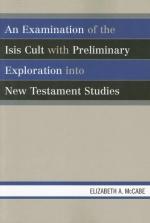|
This section contains 3,145 words (approx. 11 pages at 300 words per page) |

|
ISIS is one of the most important deities in the Egyptian pantheon. The hieroglyph for her name was the throne, and she was portrayed with a headdress in the shape of a throne. Scholars postulate that Isis was the personification of the throne or that her name means "the one who has ruling power." Jan Bergman concludes in "Isis" (1980, col. 188) that the explanation of her name points to a later priestly interpretation. The name Isis appears securely for the first time in the fifth dynasty (2465–2325 BCE) and in the Pyramid Texts at the end of the Old Kingdom (2650–2152 BCE). The first depiction of the goddess occurred almost a thousand years after the first textual mention in the eighteenth dynasty (1539–1295 BCE).
In the Heliopolitan rendering of the nine premier Egyptian gods, Isis was the daughter of Geb and Nut (Earth and Sky). Osiris was her brother and husband, Horus...
|
This section contains 3,145 words (approx. 11 pages at 300 words per page) |

|


